As many growers can concur, bonsai trees are a great art form representing nature most realistically. These painstakingly tended trees originated in ancient Chinese and Japanese cultures and are proof of patience, expertise, and the ability to nurture nature. The appeal of bonsai is not just aesthetic; it is also the profound sense of harmony and tranquility it imparts to any environment.
Despite their miniature sizes, they’re unbelievably valuable. A rare and ancient specimen can cost as much as $2 million, prompting ambitious and passionate gardeners worldwide to consider nurturing the plants.
Indeed, growing bonsai trees is a worthwhile investment. Sinking a few hundred dollars into the venture can bring huge returns within several years. But don’t get too excited yet — the task isn’t a piece of cake because the species is demanding. However, with a wealth of information about what it takes to care for the plant, you can still ace it, even with little experience.
Join us as we explore the techniques and care needed to grow and preserve these living works of art as we delve into the fascinating world of bonsai.
Fertilizing Bonsai Trees: What You Should Know
Feeding your bonsai tree is crucial throughout the growing season. It helps the plant grow strong and healthy, allowing it to maintain shape with alternating branches. Be sure to fertilize it once weekly from early spring to mid-fall. However, some species can be fed less often during various seasons. For example, deciduous bonsai trees drop their leaves in autumn and require little or no fertilization during the winter.
Nevertheless, the same doesn’t apply to conifer trees, so you should fertilize them several times throughout the cold season. Again, most indoor tropical and subtropical bonsai trees grow all year, begging the need for you to feed them monthly. Since their rapid growth period comes between spring and autumn, ensure they get plenty of fertilizer weekly.
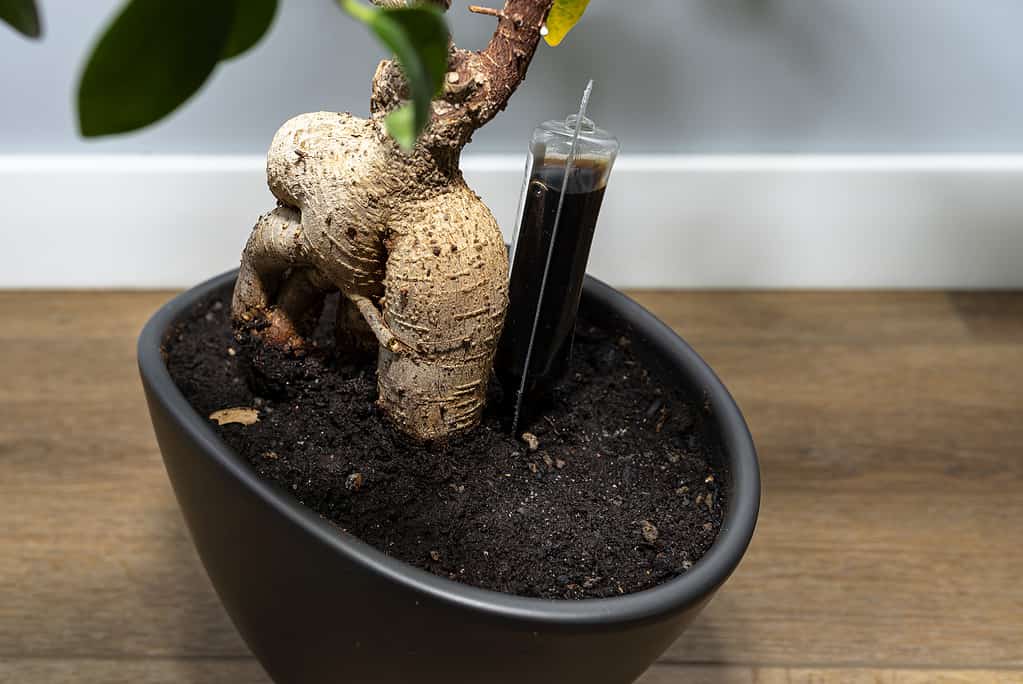
Enhancing the health and vitality of a bonsai tree through proper fertilization techniques is important.
©iStock.com/Kinek00
Which Is the Best Fertilizer for a Bonsai Tree?
The market is jam-packed with bonsai tree fertilizers you can get for your cherished plant. Always be careful when choosing yours to ensure it has the nutrients your tree needs. These are the top factors to mull over before making your pick:
Nutrient Content
Like all plants, bonsai trees require specific nutrients to thrive. The fertilizer you opt for should give them those nutrients to avoid stunted growth or death. These include macronutrients such as:
- Nitrogen: Facilitates chlorophyll production and leafy growth.
- Potassium: Besides aiding photosynthesis, potassium regulates water uptake and helps to keep diseases at bay by improving the plant’s infection resistance.
- Phosphorous: Helps the bonsai tree develop a robust root system or flowers if necessary. The nutrient also allows for energy storage and transference.
The ideal bonsai tree fertilizer should include essential micronutrients for optimal growth. These are crucial elements the plant needs in small quantities to develop appropriately. A great example is iron, which aids respiration and photosynthesis, not to mention prevents chlorosis. Another handy micronutrient is manganese, which is essential for energy production to promote biological processes such as growth and reproduction.
As you scour the market for the best fertilizer for your bonsai tree, understand your plant’s requirements to know the nutrients to prioritize.
Bonsai Tree Requirements
Various bonsai trees come with different nutritional needs that you should know about before purchasing fertilizer to feed them. The standard formula for most species is NPK 2-1-1, but fruiting or flowering bonsai trees will require more phosphorus for blooming.
Moreover, it would be best to consider seasons or where your plant is when choosing the best fertilizer. We recommend balanced options like NPK 6:6:6 for spring. In autumn, choose low-nitrogen options such as NPK 3:6:6.
At the same time, outdoor bonsai depend upon high-nitrogen fertilizers like NPK 10:6:6 to promote vigorous growth, even in harsh conditions.
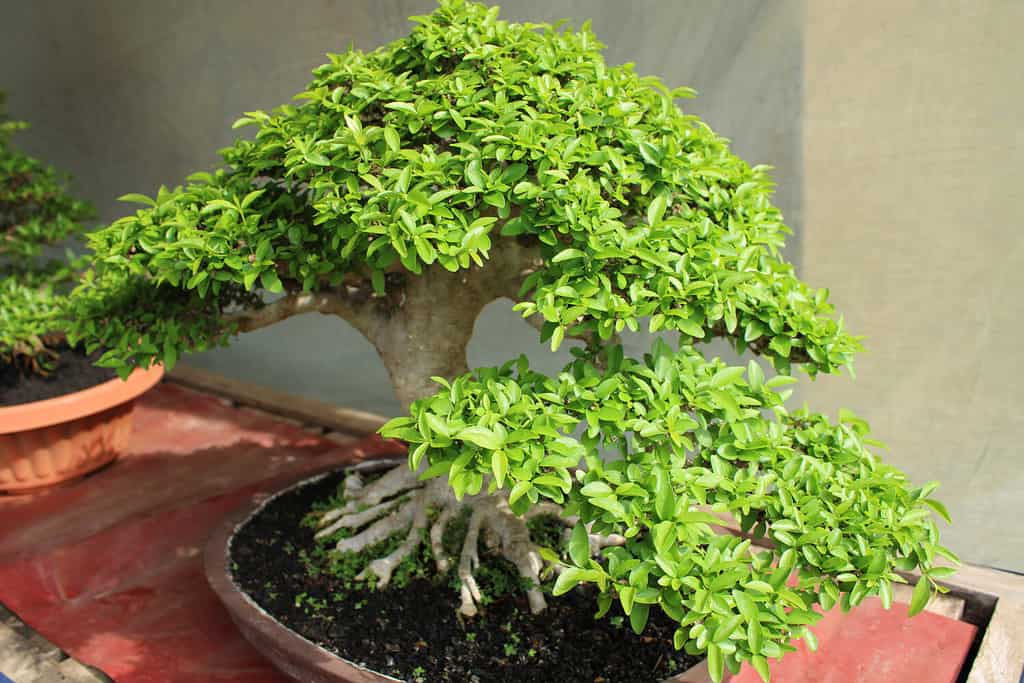
Various bonsai trees have different nutritional requirements. Choosing the correct fertilizer will impact your tree’s growth.
©hidayat R/Shutterstock.com
Organic vs. Inorganic Bonsai Fertilizers
Usually, there are two types of bonsai fertilizers — organic and inorganic. Each option presents a set of pros and cons you should grasp before purchasing.
Organic Fertilizers
These are safe, eco-friendly bonsai fertilizers that growers apply directly to the soil surrounding the tree. Popular options for bonsai tree fertilization include:
- Bone meal
- Seaweed
- Blood meal
- Fish emulsion
- Feather meal
One of the organic fertilizers’ main selling points is they come with a complex molecular structure that allows them to release nutrients slowly. That aspect reduces the number of applications you must make within a particular growing season. Again, the material improves the soil quality around the plant, thanks to colloids — the molecules formed from the decaying matter.
Organic fertilizers lack consistent nutrient content, posing a disadvantage. Some even lack essentials like nitrogen, phosphorus, and potassium, meaning you can’t bank on them to nourish your bonsai trees. They could also make the soil too compacted for the plants, inhibiting proper root development and overall growth.
Inorganic Fertilizers
These are synthetic chemical compounds manufactured to provide quick-release nutrients to bonsai trees. Unlike organic options, they guarantee necessities like nitrogen, phosphorus, and potassium in specific amounts. Moreover, you can quickly get them from your local store at affordable prices, and they also enhance ground cover.
Unfortunately, inorganic fertilizers have some disadvantages too:
- They require careful application as they can burn the plant if it’s done incorrectly.
- They may cause salt buildup in the soil, damaging the bonsai tree’s roots.
- They usually upset the ecosystem since they’re made from chemical compounds.
- They make plants, including bonsai trees, more susceptible to pest attacks.
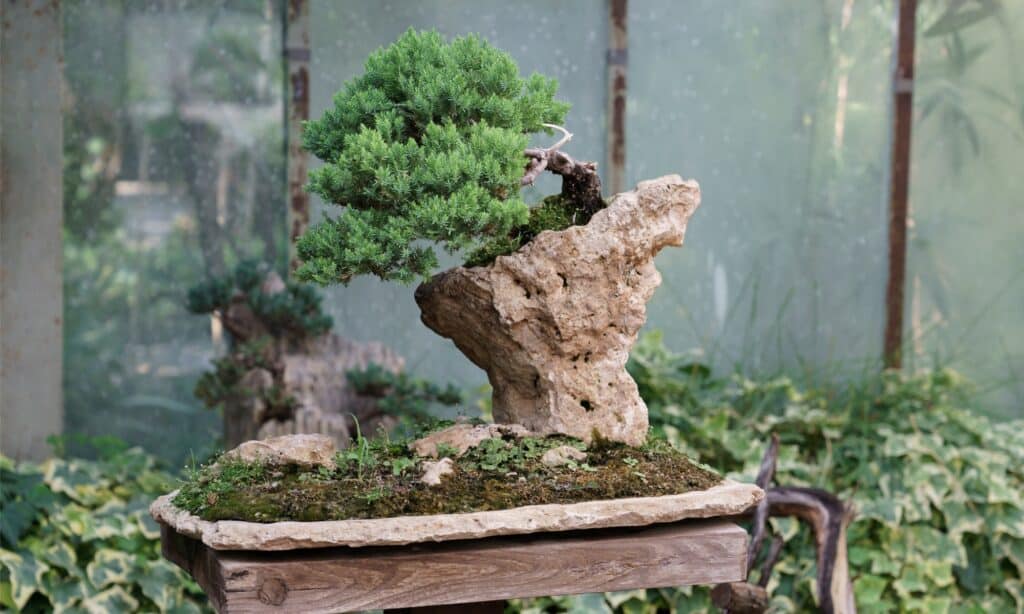
Understand the benefits and considerations of each type of fertilizer for optimal bonsai tree health and growth.
©iStock.com/Dima Berlin
Fertilizer Form
Here’s another aspect to consider when looking for the best fertilizer for your young or old bonsai tree. Typically, there are two forms; solid and liquid. Some growers prefer the latter because dosing is a walk in the park and acts fast. To apply, add it to a small bucket with water and use it to feed the tree daily. Here are more advantages of liquid fertilizers:
- They’re organic, guaranteeing a slow release of handy nutrients.
- They’re economical since about 100-250 liters can last up to a year.
- They minimize the chances of over-fertilization, protecting your bonsai tree from damage.
- They are odorless, making them suitable for both outdoor and indoor bonsai.
Solid or granular fertilizers are also popular in the bonsai world. Their primary benefit is they will continually supply the species with nutrients in small concentrations. Once you spread them on the soil’s surface area, you can wait up to two or three months to do it again, saving you much time and effort.
Combining solid and liquid fertilizers to meet your bonsai plant’s general and particular needs is advised to avoid root burns from over-fertilizing.
Affordability
Ultimately, the best fertilizer for your bonsai tree is one you can afford. Be sure to explore the online and offline markets to find them based on your budget. But that doesn’t give you the green light to ignore a certain nutrient content to save money.
Remember, the primary goal behind fertilizing a bonsai tree is to provide it with the nutrients it needs to flourish. Otherwise, the time and energy you put into nurturing it will be in vain.
How to Fertilize a Bonsai Tree?
Have you already chosen a suitable fertilizer for your bonsai tree? It’s time to decide on the best approach to feed the plant, depending on its type and age. For example, specimens in their early stages must be fertilized more often to boost root and foliage growth. We also endorse this strategy for growers nurturing coniferous and deciduous bonsai trees.
On top of that, your choice of fertilizer will ultimately affect how you fertilize your bonsai tree. Solid organic options should be applied after 4-6 weeks because they act slowly and take time to break down on the soil’s top layer. Using more is unnecessary if they’re still on the surface after a month.
On the other hand, liquid fertilizers act fast and should be applied every 10-14 days to spark maximum growth. When cultivating pre-bonsai, feed the plant twice the usual amount. But if you have just repotted the tree, wait 4-6 weeks before fertilizing it again. It protects the new root growth against burning.
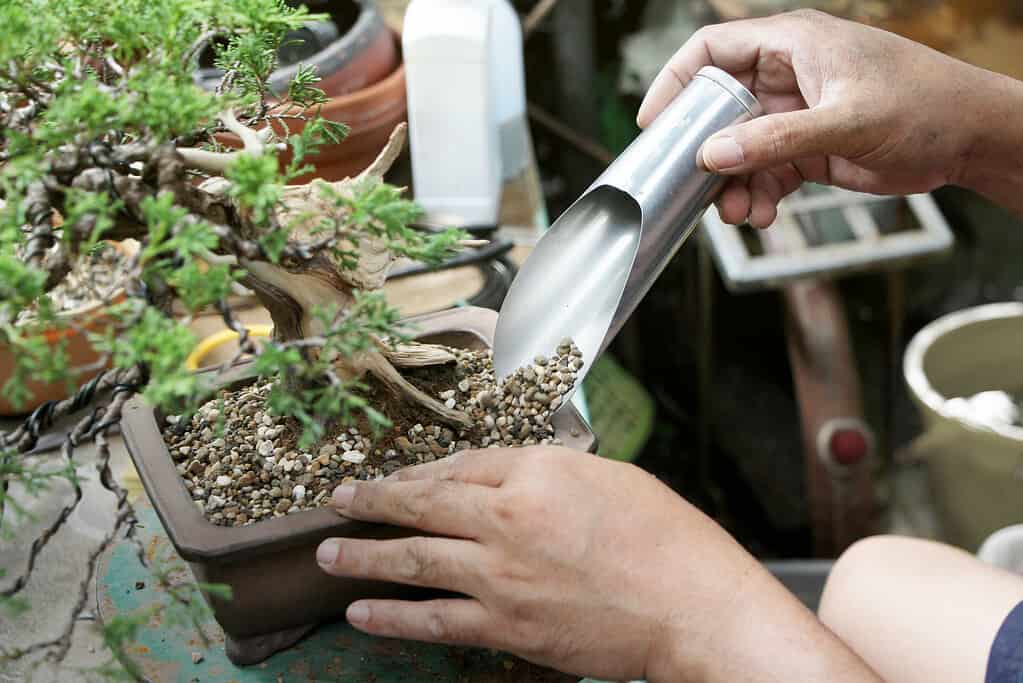
Learn the proper techniques and steps to fertilize your bonsai tree, ensuring optimal nutrient uptake and healthy growth.
©iStock.com/PAKAPORN YAMANON
Should You Fertilize Bonsai Trees in Refinement?
If your bonsai tree is in refinement, be extra cautious when fertilizing it. Overfeeding can result in undesirable results like dying foliage, long internodes, and coarse growth, which is the last thing you need when refining your cherished plant.
Nevertheless, how often you should fertilize your bonsai tree in refinement rides on its type. For example, conifers at that stage of development require feeding two or three times yearly if you’re using a solid fertilizer.
Conversely, apply liquid fertilizers after every three months, increasing or decreasing the frequency depending on how the bonsai tree responds. For example, if it exhibits slow growth and the leaves start to fall off too early or turn yellow, hold back on fertilization.
Rectifying Over-Fertilizing
It’s not unusual for a grower to over-fertilize their bonsai tree, especially if they’ve just begun nurturing these plants. Should you make such a blunder, don’t stress over it because you can quickly correct it to avoid ramifications such as course growth.
So, one of the steps to take after over-fertilizing a bonsai tree is to flush the soil. Here’s how you do it:
- Water the soil surrounding the plant generously.
- Ensure the water pours out the pot’s bottom.
- Repeat the process 2-3 hours later and the following day to rid the soil of excess fertilizer.
Repotting is another tried and tested method to avoid the unpleasant effects of over-fertilizing a bonsai tree. However, it can be extremely taxing for amateur and professional growers. Research the procedure to get it right and avoid damaging your tree.
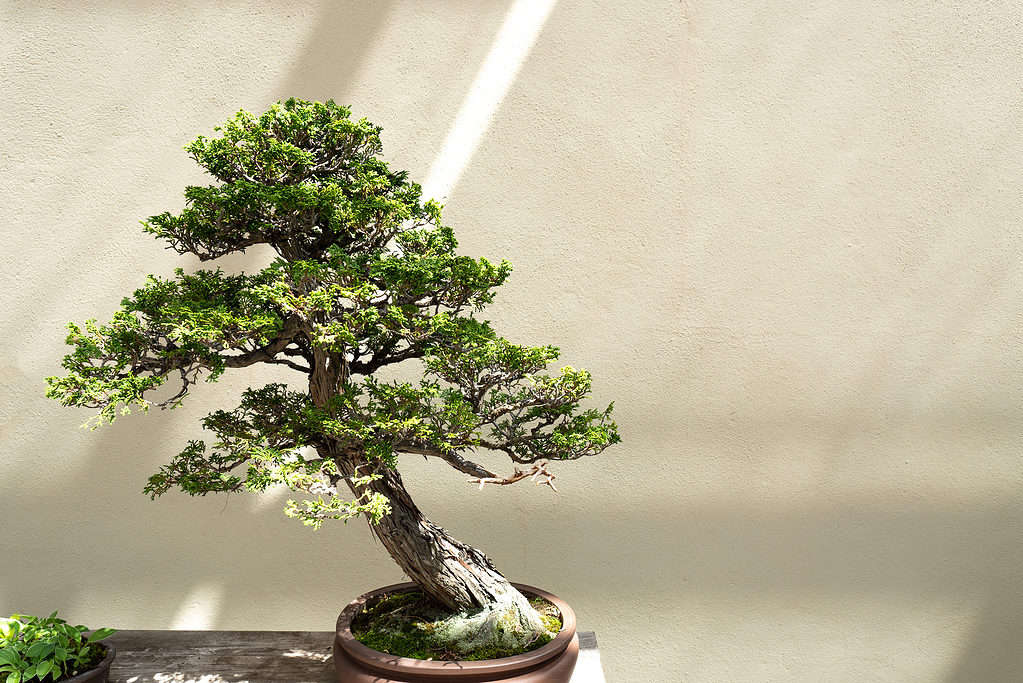
If you over-fertilize your bonsai tree, there are several steps you can take to restore its health and maintain the delicate balance of nutrients.
©iStock.com/Renata Tyburczy
Growing Bonsai Trees: Growing Instructions for Gardeners
As experienced bonsai tree growers already know, fertilizing the species is just one of the many things you must do to nurture them.
Your care routine should also include the following:
Placement
Picking the right location to place your bonsai is essential to caring for it. These species require plenty of sunlight to produce their small delicate leaves and grow properly. So, if you’re developing an indoor bonsai, position it near a well-lit, south-facing window to receive the ample light it craves.
Selecting a spot to place your outdoor bonsai should be a breeze since you only need to pick a bright patch getting direct sunlight. But watch out for harsh weather that might be unfriendly to your plant.
In the summers, provide shade for your bonsai tree during hot afternoons to protect the foliage from sunburn. The plant will also require sheltering during the cold winters, as the storms and snow can easily damage it.
Replanting
Repotting a bonsai tree prevents the plant from starving and being pot-bound. You should do it every two years for younger specimens and every 3-5 years for older ones.
The most reasonable time to repot bonsai trees is in the early spring because the plants are dormant and the buds are beginning to swell — it enables them to recover quickly. At that time, they also lack much full-grown foliage, so the damaging effects of replanting will be minimal.
However, sometimes, repotting your bonsai tree isn’t always a good idea, despite the procedure’s fantastic benefits. These instances include:
The Tree is ill
If your bonsai tree exhibits signs of sickness, such as yellowing or browning foliage, it’s best to postpone repotting. Transplanting is usually stressful for these plants, and doing it while they’re unwell might induce more shock than they can handle.
Therefore, please wait until your bonsai tree is healthy to repot it; this could be after a few weeks or months, depending on its current condition.
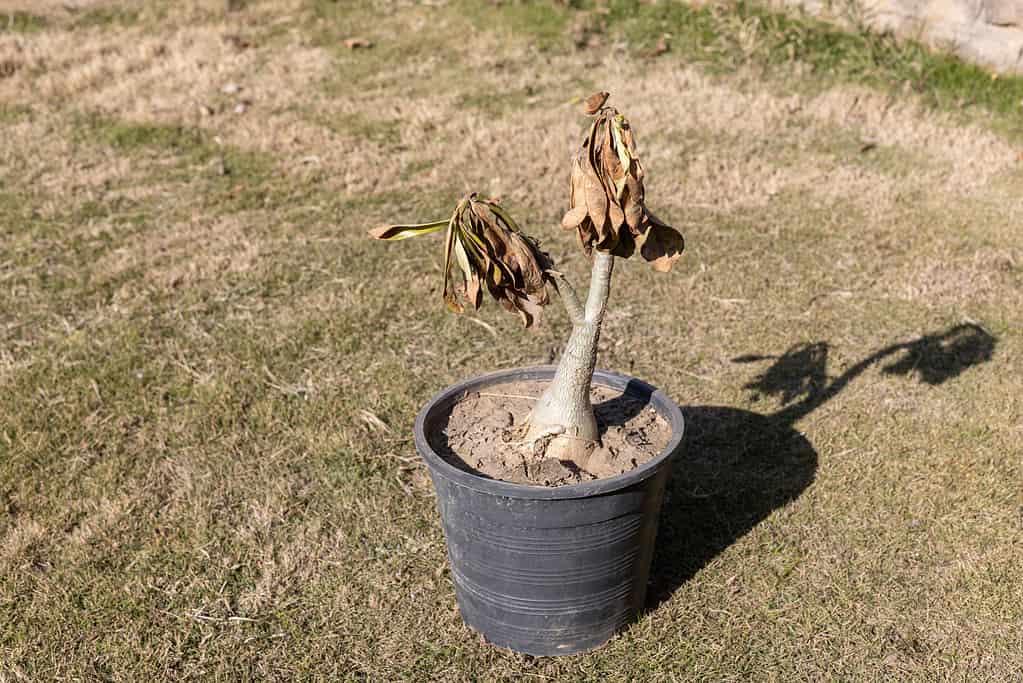
Diagnosing and treating common ailments that may affect your bonsai tree’s health ensures its vitality and longevity in your care.
©iStock.com/Bilal photos
Summer or Winter
Repotting a bonsai tree in the summer or winter is one of the most damaging mistakes you could ever make. Let’s show you why.
For starters, bonsai trees’ roots don’t grow in the summer. Their tiny pots with limited space only provide a little room for development in the hot weather. Their general activity drastically reduces during the latter, so most functions, including root development, are on hold. Hence, repotting the plants at the time reduces their chances of recovering, often resulting in death or stunted growth.
Again, we don’t recommend repotting bonsai trees in the winter because their roots stop growing with too low temperatures. Consequently, this minimizes the likelihood of the plant healing from the transplant shock.
Fertilizing Your Bonsai Tree is a Prime Concern
Ideally, there are more than 20 bonsai species today, each requiring fertilization to thrive. The procedure offers the plant a balanced diet, guaranteeing limitless access to essential nutrients like nitrogen, zinc, and manganese. Therefore, prioritize this procedure to witness your bonsai tree thrive.
Also, remember that mastering the proper fertilizing routine is the key to seeing your bonsai tree thrive as the years go by. Follow the fertilizer manufacturer’s instructions and adequately water the plant after application. We even recommend creating a watering schedule based on the species you’re nurturing and environmental conditions.
As you follow your indoor or outdoor bonsai tree fertilization routine, take other critical measures to promote proper growth. For instance, it’s crucial to time the plant’s repotting and ensure it gets at least 5 to 6 hours of sunlight daily.
To summarize, fertilizing a bonsai tree is essential to its upkeep and development. You can ensure the health and vitality of your bonsai by being aware of its particular requirements and using the proper fertilization techniques.
You can keep your bonsai tree growing and beautiful for years by keeping track of it regularly, modifying the fertilization plan as necessary, and watching how it responds. With persistence, wisdom, and attention to detail, you can watch your bonsai flourish and bring you joy as a living work of art.
The photo featured at the top of this post is © iStock.com/Sangwien
Thank you for reading! Have some feedback for us? Contact the AZ Animals editorial team.







